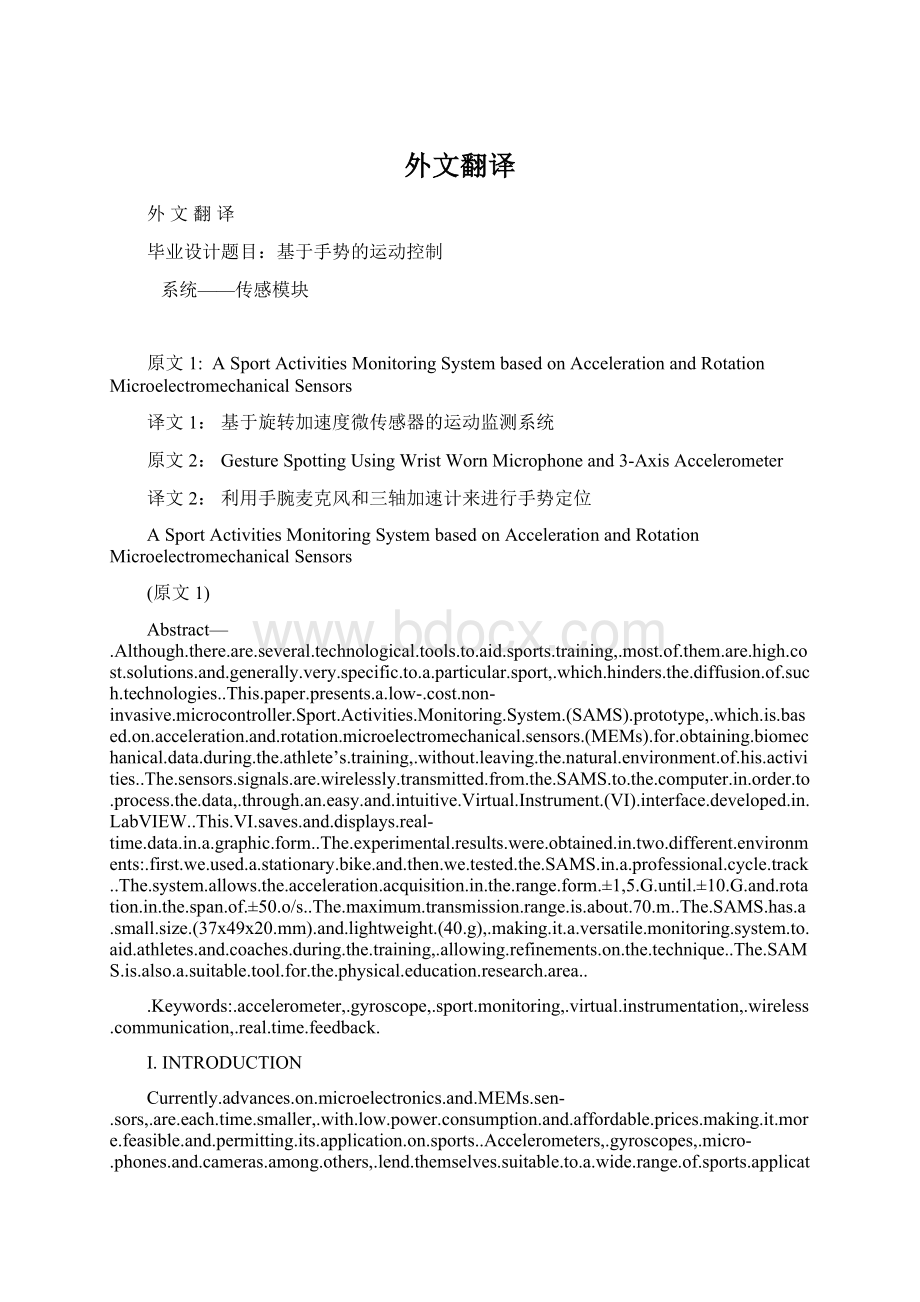外文翻译.docx
《外文翻译.docx》由会员分享,可在线阅读,更多相关《外文翻译.docx(31页珍藏版)》请在冰豆网上搜索。

外文翻译
外文翻译
毕业设计题目:
基于手势的运动控制
系统——传感模块
原文1:
ASportActivitiesMonitoringSystembasedonAccelerationandRotationMicroelectromechanicalSensors
译文1:
基于旋转加速度微传感器的运动监测系统
原文2:
GestureSpottingUsingWristWornMicrophoneand3-AxisAccelerometer
译文2:
利用手腕麦克风和三轴加速计来进行手势定位
ASportActivitiesMonitoringSystembasedonAccelerationandRotationMicroelectromechanicalSensors
(原文1)
Abstract—.Although.there.are.several.technological.tools.to.aid.sports.training,.most.of.them.are.high.cost.solutions.and.generally.very.specific.to.a.particular.sport,.which.hinders.the.diffusion.of.such.technologies..This.paper.presents.a.low-.cost.non-invasive.microcontroller.Sport.Activities.Monitoring.System.(SAMS).prototype,.which.is.based.on.acceleration.and.rotation.microelectromechanical.sensors.(MEMs).for.obtaining.biomechanical.data.during.the.athlete’s.training,.without.leaving.the.natural.environment.of.his.activities..The.sensors.signals.are.wirelessly.transmitted.from.the.SAMSputer.in.order.to.process.the.data,.through.an.easy.and.intuitive.Virtual.Instrument.(VI).interface.developed.in.LabVIEW..This.VI.saves.and.displays.real-time.data.in.a.graphic.form..The.experimental.results.were.obtained.in.two.different.environments:
.first.we.used.a.stationary.bike.and.then.we.tested.the.SAMS.in.a.professional.cycle.track..The.system.allows.the.acceleration.acquisition.in.the.range.form.±1,5.G.until.±10.G.and.rotation.in.the.span.of.±50.o/s..The.maximum.transmission.range.is.about.70.m..The.SAMS.has.a.small.size.(37x49x20.mm).and.lightweight.(40.g),.making.it.a.versatile.monitoring.system.to.aid.athletes.and.coaches.during.the.training,.allowing.refinements.on.the.technique..The.SAMS.is.also.a.suitable.tool.for.the.physical.education.research.area..
.Keywords:
.accelerometer,.gyroscope,.sport.monitoring,.virtual.instrumentation,munication,.real.time.feedback.
I.INTRODUCTION
Currently.advances.on.microelectronics.and.MEMs.sen-.sors,.are.each.time.smaller,.with.low.power.consumption.and.affordable.prices.making.it.more.feasible.and.permitting.its.application.on.sports..Accelerometers,.gyroscopes,.micro-.phones.and.cameras.among.others,.lend.themselves.suitable.to.a.wide.range.of.sports.applications.[1],.making.possible.to.obtain.biomechanical,.physical.or.cognitive.information.from.monitoring.the.athletes.performance.during.their.trainings.or.sport.practices..Nmunication.standards.like.Bluetooth.and.ZigbeeTM.,working.sensors,.that.can.be.widely.applied.in.the.healthcare.and.in.sports.[2].since.it.allows.data.transmission.without.mobility.interfering..The.athlete’s.performance.depends.on.the.environment.where.he.or.she.is.being.monitored.[2],.for.example:
.laboratory,.inside/outside.training,.competition.or.playing.field.conditions..In.addition.to.that,.it.is.known.that.when.feedback.is.provided.in.an.appropriate.manner,.motor.skill.acquisition.improves.significantly..Consequently,.feedback.is.a.major.factor.in.the.improvements.of.sport.skill.performance.[3]..Furthermore,.systems.with.immediate.feedback.increase.the.athlete’s.motivation.
II..HARDWARE.SYSTEM.PROTOTYPE
Figure.1.shows.the.block.diagram.of.the.Sport.Activities.Monitoring.System.(SAMS).prototype,.which.is.divided.in.two.boards:
.the.first.one,.has.the.acceleration.and.rotation.sensors,.a.microcontroller,.a.radiofrequency.module.and.a.battery..This.is.the.mobile.part.of.the.prototype.and.can.be.attached.to.the.athlete’s.body..The.second.board,.also.called.base.station.board,.was.adapted.from.a.USB-RogerCom.board.[4],.and.incorporates.a.radiofrequency.module..Tputer’s.USB.port,.in.order.to.acquire.the.sensors’.data.
The.prototype.sensors.were.chosen.by.taking.into.account.their.operation.range,.size,.energy.consumption,.number.of.axes,.type.of.output,.encapsulation.and.price,.keeping.this.in.mind,.the.accelerometers.MMA7260.and.MMA7261.from.FreescaleTM.and.the.gyroscopes.IDG-.300.and.IDG-1004.from.InvenSenseTM.were.chosen..With.regards.to.the.microcontroller,.we.selected.a.low.power,.eight.bit.MC9S08QE128.from.FreescaleTM...The.radiofrequency.module.Xbee/XbeePro.from.DigiTM.,.and.a.rechargeable.3,7.V.lithium.prismatic.battery.were.also.selected.
.Accelerometers:
.The.MMA7260.(introduced.in.2005.by.FreescaleTM.[5]).and.the.MMA7261.[6].are.MEM’s.tri-axis.acceleration.sensors.with.selectable.sensitivity.(1,5/2/4/6.G),.low.current.consumption.(500.μA),.sleep.mode.(3.μA),.low.voltage.operation.(2,2.to.3,6.V).and.low.cost.(3,35.USD)..The.output.voltage.is.ratiometric.and.proportional.to.the.acceleration,.this.simply.means.that.the.output.offset.voltage.and.sensitivity.will.scale.linearly.with.applied.supply.voltage..Table.I.presents.the.typical.sensitivity.for.3,3.V.power.supply.voltage.and.Figure.2.shows.the.sensor.dynamic.acceleration.axis.
Gyroscopes:
.The.IDG-300.and.IDG-1004.are.an.inte-.grated.dual-axis.angular.rate.sensors.(gyroscopes)..Both.of.them.use.InvenSenseTM.’s.proprietary.and.patented.MEMS.technology.with.vertically.driven,plete,.dual-axis.angular.rate.sensor.[7]..The.output.voltage.of.the.gyroscope.is.proportional.to.the.angular.velocity..The.IDG-300.full.scale.range.is.±500.o/s,.sensitivity.2.mV/./s,.low.voltage.operation.(3,0.to.3,3.V).and.low.cost.(30.USD)..For.IDG-1004.[8].the.main.difference.is.the.full.scale.range.±50.o/s,.and.the.sensitivity.4.mV/.O/s..Figure.3.presents.the.rotation.axis.and.the.gyroscope.board.witch.is.going.to.be.part.of.the.SAMS,.allowing.to.obtain.the.yaw.rotation.
Xbee/XbeePro.Modules:
.Wmunication.between.the.mobile.board.and.the.base.station.board.was.achieved.with.the.Xbee/XbeePro.RF.modules.from.Digi..This.modules.were.introduced.in.the.market.in.2007,.and.were.designed.to.meet.the.IEEE.802.15.4.standard.(ZigBeeTM)..The.modules.operate.within.the.ISM.(Indus-.trial,.Scientific.and.Medical).2.4.GHz.frequency.band,.send-.ing.and.receiving.signals.and.physically.pin-to-pati-.ble.with.each.other.[9]..Figure.4.presents.the.Xbee/XbeePro.modules.
Toincrease.the.possible.test.scenarios,.two.different.versions.of.the.SAMS.were.constructed.and.their.characteristics.are.presented.in.Table.II.
III.SOFTWARE.SYATEM.PROTOTYPE
The.software.of.the.Sport.Activities.Monitoring.System.(SAMS).prototype,.was.divided.in.two.parts..The.first.one,.is.a.firmware.programmed.in.C.into.the.microcontroller,.this.firmware.controls.all.the.process.in.the.mobile.board,including:
.data.acquisition,.optional.processing,.power.consumption,.and.data.transmission..The.second.part.of.the.software,.is.a.Virtual.Instrument.(VI).interface.developed.
on.LabVIEW,.which.is.a.graphical.programming.language.that.has.been.widely.adopted.throughout.industry,.academia,.and.research.labs.as.the.standard.for.data.acquisition.and.instrument.control.software.[10]..This.VI.allows.the.selec-.tion.of.the.sensors.which.are.going.to.be.use,.select.the.acceleration.range,.enable.preprocessing,.along.calibration,.data.processing,.saving.and.displaying.real.time.data.in.a.graphic.form.over.an.intuitive.user.interface..The.SAMS’.frontal.panel.is.presented.in.Figure.6.
SAMS.calibration:
.In.order.to.eliminate.the.offset.from.the.sensors,.a.calibration.process.was.developed..This.pro-.cess.measured.the.gravity.acceleration.by.each.one.of.the.accelerometer.axes.in.three.different.positions.by.aligning.the.normal.vector.of.the.sensor,.with.the.gravity.vector.in.every.position.and.keeping.the.other.axis.without.acceleration..For.the.calibration.task,.the.program.guides.the.user.to.align.the.sensor’s.box.in.each.one.of.the.positions.as.shown.in.Figure.7..Finally,.after.the.calculations,.the.offset.value.for.every.axis.is.saved.in.a.file.and.read.by.the.SAMS’.VI.during.the.startup..
.SAMS.fixation.and.orientations:
.The.SAMS.was.encap-.sulated.and.adapted.with.a.fixation.system.to.let.it.be.easy.fasten.to.the.athlete..The.axis.and.rotation.coordinates.are.presented.in.Figure.8.
IV.EXPERIMENTAL.RESULTS
The.experimental.results.were.obtained.in.two.different.environments:
.first.we.use.a.stationary.bike.and.then.we.tested.the.SAMS.on.a.professional.cycle.track..In.these.bike.test,.the.sensor.was.fixed.in.the.right.ankle.of.the.athlete.as.shown.in.Figure.9.
Stationary.bike.test:
.One.of.the.tests.with.the.stationary.bike,.was.the.Wingate.test.[11]..This.is.a.test.used.to.evaluate.the.maximum.power.and.anaerobic.capacity..The.Wingate.is.a.30.seconds.test,.during.it,.the.athlete.tries.to.pedal.as.many.times.against.a.fixed.resistance,.aiming.to.generate.as.much.power.as.possible.in.that.period.of.time..The.power.generated.during.the.30.seconds.is.called.the.average.power.and.a.power.peak.usually.occurs.within.the.first.5.seconds.of.the.test..Figure.10,.11,.12.and.13,.shows.the.acceleration.and.angular.velocity.for.each.axis.and.the.temperature,.respectively.
In.the.field.tests.we.used.the.SAMS.II.prototype,.with.an.acceleration.range.of.±10.G.and.rotation.span.of.±50.?
/s..Figure.14.presents.the.acceleration.A.and.rotation.Yaw.(V.).during.the.firsts.five.seconds.of.the.Wingate.test..In.this.time.window,.a.clear.view.of.the.signals.format.is.presented.with.a.maximum.acceleration.peak.of.98.m/s.in.the.Xponent.
Cycle.track.test:
.In.the.cycle.track.test.the.SAMS.was.tested.in.a.real.sport.scenario,.with.a.maximum.wireless.transmission.range.about.70.m..One.of.the.tests.in.the.cycle.track.was.an.static.start.shown.in.Figure.15(a)..Figures.16,.17.and.18,.show.the.acceleration.and.angular.velocity.for.each.axis,.respectively..The.temperature.acquired.by.the.SAMS.is.shown.in.Figure.15(b).
V.CONCLUSIONS.AND.FUTURE.WORKS
A.Conclusions
*.The.calibration.process.made.with.SAMS.was.success-.fully.implemented,pare.measured.accelerations.in.magnitude.with.a.minimum.margin.of.error.
*.The.SAMS.has.small.size.(